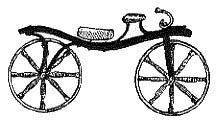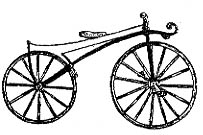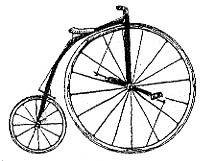|
The
invention of the bicycle was motivated by a desire to develop
a form of personal transport. The bicycle paved the way for
the car, but has remained a popular form of transport and
leisure activity.
The
bicycle is a universally accepted form of personal transport.
Bicycle ownership world wide is extensive; 43% of the Australian
population own bikes, 49% in Japan and 80% in the Netherlands.
These figures perhaps reflect the consideration given to cyclists
— through paths, cycleways, and laws which make cycling
a safe and appealing experience. In Asia, bicycles and other
pedal-powered machines, such as rickshaws, trishaws, becaks
and pedicabs, are often the main form of personal transport
and transportation of goods.
 Cycloped.
Photo:
Lisa Branson
Cycloped.
Photo:
Lisa Branson |
The
first example of a bicycle was the draisienne or hobbyhorse
developed in 1818 by Baron von Drais (Germany). It relied
on foot propulsion instead of pedals. The draisienne
proved that a person could keep balance while the bike was
in motion.
To
find out more about the history of bicycles select from the
following options:

Draisienne or hobbyhorse |
Scottish
blacksmith Kirkpatrick Macmillan created a treadle-driven
bicycle in 1839. He used this bicycle as transport, sometimes
travelling up to 70 km.
It
was not until 1863 that Parisian Pierre Michaux, while repairing
a draisienne, realised that by fitting cranks to the
front wheel pedals could be used. He set up a business with
his son and called this machine the velocipede. It
became a popular form of transport for short journeys. Velocipedes
continued to be built until 1870. The velocipede was
further modified in England. James Starley produced an improved
version of the velocipede by 1868.

Velocipede |
| While
evidence suggests that there may have been a few hobbyhorses
in Australia in the 1840s, it was the velocipede which
really began to interest Australians in cycling. The first
of these machines was introduced into Melbourne in 1868
and, in the following July, Australia's first bicycle
race was held at the Melbourne Cricket Ground. |
In
1870 James Starley, with William Hillman (England), developed
the ariel, officially known as the ordinary
bicycle, nicknamed the penny-farthing. The very large front
wheel allowed an increase in the distance covered per turn
of the pedal. The penny-farthing became an immediate success
in Australia. Clubs were formed in each colony and by 1884
there were thirty. Like the football and soccer clubs of today,
each had its registered colours, and members were expected
to wear uniform whenever they went cycling in a group.

Penny-farthing
or Ariel |
Modifications
to parts of the bicycle
Wheels
The wheel in the early penny-farthings had wooden spokes.
Starley and Hillman experimented with wire. The earliest
wire spoke wheels were easily buckled as the spokes radiated
from the hub to the rim. Starley designed the tangentially
spoked wheel to avoid buckling and twisting. Improvements
in materials technology have enabled much higher spoke
tensions to be obtained, thus further reducing the likelihood
of buckling. |

the
tangentially spoked wheel
|
Tubular
frames
Starley was also concerned about the weight of the bicycle.
The frame was solid metal. Through much experimentation he
found that hollow metal circular tubes offered strength with
reduced weight. Tubular framed penny-farthings were produced
by 1877.
Ball
bearings
Another development in 1877 was ball bearings. One of the
problems of the wheel-bearing in the penny-farthing was the
friction caused by the wheel hub turning on the axle. The
metal-to-metal contact resulted in the surface wearing out.
Ball bearings prevent friction and are used in many machines.
In today's bicycles, ball bearings are found in:
- the
steering column
- the
pedal crank shaft
- the
pedals
- the
wheel hubs.
Further
developments
While penny-farthings were very popular they were also quite
dangerous. The next major development was the bicyclette
by Henry Lawson in 1879 in England. The two wheels were more
similar in size. The bicyclette featured:
- pedals
- sprocket
wheels
- a
chain.
The
bicyclette was not a commercial success because of its complexity.
James Starley's nephew produced the Rover or 'safety' bicycle
in 1885 (England). This design resulted in a huge increase
in bicycle riding. Millions of people, men and women, took
to the roads.

Rover safety bicycle |
See
Bicycle engineering highlights
for further developments, such as the bush roller chain and
the pneumatic tyre.
Changing
gears
The last major engineering hurdle for the bicycle was how
to reduce the effort needed to ride a bike uphill or against
a strong wind. The results were:
- the
derailleur gear-change system (1899)
- the
Sturmey-Archer hub three-speed gear (1902).
Both
are still used today.
Other
developments
Developments from this point included:
- new
materials, such as aluminium, alloys and plastic
- lighting
generated in the wheel hubs
- drum
brakes
- caliper
brakes: centre pull, side pull and hydraulic.
In
1959, British designer Alex Moulton developed a small-wheel
cycle where the wheels were separately sprung improving suspension.
The Moulton was designed with small wheels to allow space
above the rear wheel to carry items in a tray. It was the
first major bicycle re-design in years.

Moulton
bicycle |
BMX
A decade later, in 1971, the Bicycle Motor Cross (BMX) was
developed in the USA, using a chrome molybdenum frame. The
BMX allowed riders to manoeuvre their bikes at speed over
rough terrain. BMX created a renewed interest in bike riding
which has resulted in further developments in bicycles for
mountain bike riding.
Monocoque
frames
Track and road cycling as sports have continued to attract
interest and research and development. Developments now are
influenced by technical rulings of the Union Cycliste Internationale
(UCI) which have seen the development of monocoque frames,
in particular:
- the
Zipp 2001 Multisport (Zipp Speed Weaponry, USA)
- the
LotusSport carbon-fibre, aerodynamic by Mike Burrows for
Lotus Engineering
- the
AIS/RMIT Superbike.
Track
cycling
Kirkpatrick Macmillan won the first pedal bicycle race in
1842. Track cycling was included at the first modern Olympic
games in 1896. The events were gruelling. The programme has
been modified and now track cyclists compete in sprint and
endurance races, individual and team events, time trials,
first-over-the-line finishes and pursuits. Women's events
were not scheduled at the Olympics until 1988, when the 1000
m sprint event was run. At the 2000 Games there were women's
sprints, time trials and pursuit events.
Road
racing
The first Olympic road race in 1896 was held on the marathon
course, from Athens to Marathon. Riders completed two laps,
a total of 87 kilometres. Almost one hundred years later,
in 1984, women were able to participate in the road race.
Mountain
bike racing
The first cycling race was the road race followed by track
racing and mountain biking or 'clunking'. Mountain biking
dates back to 1953 and was developed in the United States.
The first competitions were held in the 70s. The most well
known was the Repack Downhill, but it wasn't until 1996 that
it was an Olympic event.
A
Californian college student was the first to strip back his
regular bicycle to create an early version of the mountain
bike. He removed the:
- chainguard
-
horn
- tank
- racks
and
installed:
- multiple
gears
- caliper
brakes
- straighter
handlebars.
This
was just the beginning of further developments that would
lead to the now popular titanium bikes.
|
![]()
![]()
![]()